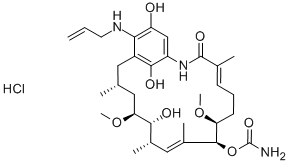857402-63-2
 857402-63-2 結(jié)構(gòu)式
857402-63-2 結(jié)構(gòu)式
基本信息
HSP90ATPASE活性抑制劑
Ipi 504
Unii-928Q33Q049
Retaspimycin HCl
IPI-504
IPI504
IPI 504
Retaspimycin hydrochloride
IPI-504 (Retaspimycin HCl)
IPI-504 (RetaspiMycin hydrochloride)
17-Allylamino-17-demethoxygeldanamycin hydroquinone hydrochloride
18,21-Didehydro-17-demethoxy-18,21-dideoxo-18,21-dihydroxy-17-(2-propen-1-ylamino)geldanamycin hydrochloride
物理化學性質(zhì)
| 報價日期 | 產(chǎn)品編號 | 產(chǎn)品名稱 | CAS號 | 包裝 | 價格 |
| 2025/02/08 | HY-10210 | 瑞他霉素鹽酸鹽 Retaspimycin Hydrochloride | 857402-63-2 | 1mg | 950元 |
| 2025/02/08 | HY-10210 | 瑞他霉素鹽酸鹽 Retaspimycin Hydrochloride | 857402-63-2 | 5mg | 1800元 |
| 2025/02/08 | HY-10210 | 瑞他霉素鹽酸鹽 Retaspimycin Hydrochloride | 857402-63-2 | 10mM * 1mLin DMSO | 2472元 |
常見問題列表
|
HSP90 119 nM (EC 50 ) |
GRP94 119 nM (EC 50 ) |
Retaspimycin (IPI-504) is a novel and highly soluble analog of 17AAG, an inhibitor of Hsp90. Retaspimycin can abrogate both the unfolded protein response element (UPRE) and ERSE-driven luciferase activity in non-treated U266 and MM.1s cells as well as in Tunicamycin (Tm)-treated cells. The IC 50 s for the inhibition of reporter gene activity by Retaspimycin are 196±56 nM in U266 and 472±177 nM in MM.1s for UPRE-luc activity and 213±140 nM for the ERSE-driven activity in MM.1s cells. Retaspimycin treatment leads to a dose-dependent decrease of p50ATF6 with EC 50 of 237 nM, consistent with the reporter-gene assay. The level of sXBP1 is decreased in the presence of Retaspimycin with an apparent EC 50 between 300 nM and 1 μM. Incubation of Retaspimycin (IPI-504) potently suppresses both Akt and MAPKs phosphorylation in both sensitive and Trastuzumab-resistant cells. Total levels of Akt decreased in all 4 cell lines (BT474, SKBR-3, HCC1569, and HCC1569) in a dose-dependent manner. However, levels of total MAPKs are not significantly altered with Retaspimycin treatment.
Retaspimycin (IPI-504) and Trastuzumab independently induce tumor regression of Trastuzumab-sensitive BT474 cell-derived xenografts. Xenografts derived from BT474R cells continue to grow in the presence of Trastuzumab but are still sensitive to Retaspimycin. When used in combination, Retaspimycin and Trastuzumab add only marginal benefits to Retaspimycin monotherapy. Retaspimycin (100 mg/kg) as a single agent is more efficacious than Trastuzumab in inhibiting tumor growth in HCC1569 xenografts. The combination is not significantly superior to Retaspimycin used as a single agent.
